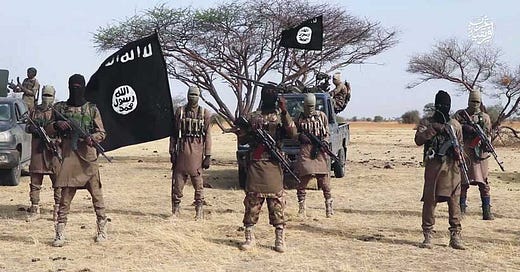Forecast of Terrorism in Africa in 2025
Introduction
The complex and dynamic landscape of terrorism in Africa reflects the continent's socioeconomic, political, and security challenges. In 2025, Africa will likely remain a critical battleground in the global fight against terrorism. Factors such as ungoverned spaces, weak governance, ethnic divisions, climate change, and the legacy of external interventions will continue to provide fertile ground for the proliferation of extremist ideologies.
This forecast examines key trends, potential developments, and strategic considerations for counterterrorism in Africa through a regional and thematic analysis. By understanding the drivers and manifestations of terrorism on the continent, stakeholders can devise more effective strategies to mitigate threats and build resilience.
I. Regional Analysis of Terrorism in Africa
A. West Africa
Key Hotspots: Nigeria, Niger, Mali, Burkina Faso, Chad, and the Sahel region.
West Africa, particularly the Sahel, remains at the forefront of Africa's terrorism crisis. Two dominant groups, Boko Haram and its splinter faction, Islamic State West Africa Province (ISWAP), will continue to exploit Nigeria and its neighbors. Meanwhile, Jama’at Nasr al-Islam wal Muslimin (JNIM), an Al-Qaeda affiliate, will dominate the Sahel region.
ISWAP's Expansion ISWAP has consolidated control over parts of northeastern Nigeria and southern Niger. In 2025, it is expected to exploit local grievances, particularly in Lake Chad Basin communities, to expand its influence. Climate-induced migration and competition over resources like water and farmland will intensify local conflicts, enabling ISWAP to recruit fighters.
JNIM’s Role in the Sahel JNIM’s pragmatic strategy of aligning with local ethnic groups and offering services in ungoverned regions will likely sustain its dominance. Burkina Faso and Mali, which have undergone political instability, will remain vulnerable to JNIM attacks targeting government and military personnel.
Governance and Security Deficits Coups in Mali, Burkina Faso, and Guinea have further weakened state institutions. In 2025, the presence of military-led regimes is expected to exacerbate human rights violations and alienate civilian populations, inadvertently fueling recruitment by terrorist groups.
B. East Africa
Key Hotspots: Somalia, Kenya, Uganda, Ethiopia, and Mozambique.
East Africa’s terrorism threat will primarily emanate from Al-Shabaab, which operates in Somalia and northern Kenya, and the Islamic State–Mozambique (IS-Mozambique), active in the Cabo Delgado province.
Al-Shabaab’s Adaptability Al-Shabaab remains a resilient force in East Africa. Despite multinational counterterrorism efforts, including African Union Transition Mission in Somalia (ATMIS), the group has demonstrated a capacity to adapt. In 2025, Al-Shabaab will likely escalate attacks on Somali urban centers and infrastructure projects funded by external actors, such as Turkey and China. Border raids into Kenya, targeting key hubs like Nairobi, will also remain a persistent threat.
Emerging Threats in Mozambique IS-Mozambique has entrenched itself in Cabo Delgado by exploiting local grievances over resource wealth distribution. In 2025, increased foreign investment in liquefied natural gas (LNG) projects may provoke intensified IS-Mozambique attacks, aiming to disrupt economic growth and undermine investor confidence.
Regional Spillover Risks Ethiopia’s internal strife and Uganda’s resurgence of Allied Democratic Forces (ADF)—an IS affiliate—pose transnational security risks. Regional instability will likely draw international counterterrorism interventions, potentially heightening anti-foreign sentiment and aiding terrorist narratives.
C. North Africa
Key Hotspots: Libya, Algeria, Egypt, and Tunisia.
North Africa, traditionally a hub for jihadist networks, continues to grapple with terrorism’s aftermath in post-conflict Libya and the Sinai Peninsula.
Libya as a Staging Ground Libya’s fragmentation has left vast territories outside state control. Armed groups aligned with Islamic State in Libya and Al-Qaeda could leverage these areas as logistical bases for operations targeting Sahel countries and Europe. In 2025, smuggling routes through Libya will also facilitate the movement of arms and fighters.
Sinai Peninsula Insurgency Egypt will face sustained insurgency in the Sinai, where Wilayat Sinai, an IS affiliate, continues its operations. Economic challenges and crackdowns on civil society will likely impede effective counterterrorism measures, enabling the group to exploit discontent in marginalized communities.
Stability in Algeria and Tunisia While Algeria and Tunisia have largely managed to contain terrorism within their borders, the resurgence of extremist cells could occur if regional instability spills over. Tunisia, facing economic decline, is particularly vulnerable to youth radicalization.
D. Central Africa
Key Hotspots: Democratic Republic of Congo (DRC), Cameroon, and Chad.
Central Africa's security landscape will be shaped by the ADF and Boko Haram activities, along with growing ties between local militias and global jihadist networks.
Resilience of ADF ADF’s ties with IS-Central Africa Province will bolster its operational capacity in 2025. Eastern DRC will see intensified attacks on civilians, UN peacekeepers, and Congolese forces. These attacks may spill over into Uganda, straining regional military resources.
Boko Haram in the Lake Chad Basin Despite ISWAP's dominance, Boko Haram remnants will maintain sporadic attacks in Cameroon and Chad, targeting civilians and local officials. This will perpetuate insecurity and displacement in the region.
E. Southern Africa
Key Hotspot: Mozambique.
While Southern Africa has traditionally been less affected by terrorism, the rise of IS-Mozambique has shifted this dynamic.
Entrenchment in Cabo Delgado IS-Mozambique’s insurgency will likely intensify, driven by grievances over extractive industries and local inequality. Regional counterinsurgency efforts led by the Southern African Development Community (SADC) will face challenges in achieving sustainable stability.
Regional Cooperation Southern Africa’s counterterrorism framework, while nascent, could gain momentum. In 2025, countries like South Africa may increase their support for counterinsurgency operations in Mozambique, although domestic political challenges might limit their engagement.
II. Thematic Trends in Terrorism in Africa
A. Climate Change and Terrorism
Climate change exacerbates Africa’s security challenges by intensifying competition for scarce resources. Prolonged droughts and desertification in the Sahel and Horn of Africa have displaced millions, creating opportunities for terrorist groups to exploit vulnerable populations. In 2025, resource conflicts driven by environmental degradation are expected to further intertwine with terrorist narratives, amplifying recruitment and radicalization.
B. Technology and Cyberterrorism
Terrorist groups are increasingly leveraging technology for recruitment, propaganda, and operational planning. In 2025:
Social Media: Platforms like Telegram and WhatsApp will continue to facilitate terrorist communication and radicalization.
Cryptocurrency: Groups may increasingly adopt cryptocurrencies for financing, bypassing traditional banking oversight.
Drones: The use of drones for surveillance and attacks could emerge, particularly among well-funded groups like IS affiliates.
C. External Interventions
Foreign interventions, including French withdrawal from Mali and increasing Russian influence via the Wagner Group, will shape Africa’s counterterrorism dynamics. In 2025, the absence of coordinated international strategies may lead to fragmented and inconsistent responses, undermining progress.
D. Local and Community Resilience
Community-led counterterrorism approaches will become more critical in 2025. Initiatives focusing on education, economic empowerment, and interfaith dialogue will be essential to counter radicalization at the grassroots level. However, achieving sustained impact will require long-term investments and collaboration among governments, NGOs, and local stakeholders.
III. Strategic Recommendations for 2025
Strengthen Regional Cooperation: African states must enhance regional mechanisms, such as the African Union’s peace and security architecture, to address cross-border threats.
Invest in Governance and Development: Addressing governance deficits and improving access to education, healthcare, and employment will help tackle the root causes of terrorism.
Adopt Technology in Counterterrorism: Governments should invest in cybersecurity and digital forensics to counter online radicalization and terrorist financing.
Promote Climate Resilience: Climate adaptation strategies, including sustainable agriculture and water resource management, can mitigate conflict drivers.
Enhance Intelligence Sharing: Improved coordination among intelligence agencies will be crucial in preempting attacks and dismantling terrorist networks.
Conclusion
The terrorism landscape in Africa in 2025 will remain multifaceted, shaped by enduring challenges and emerging dynamics. While significant threats persist, opportunities for resilience and cooperation also exist. Governments, regional organizations, and international actors must adopt a holistic and proactive approach to counterterrorism, addressing both immediate security concerns and underlying vulnerabilities. By doing so, Africa can take meaningful strides toward reducing the scourge of terrorism and fostering sustainable peace and development.
SOURCE: Osint





